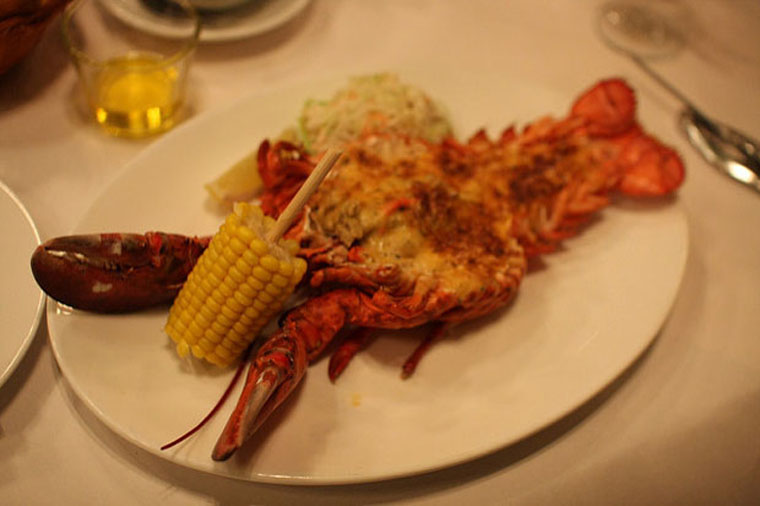Huge tuna at the Tsukiji Fish Market. Large predatory fishes at the top of the food chain are likely to accumulate more toxins.
Q: What fish is most nutritious and less contaminated with mercury?
I’ve recently returned from a trip to Penang, an island famous for its delicious food like char koay teow, asam laksa and cendol. It’s a ‘makan trip’ (eating trip) to savour the best food Penang has to offer. So I shoved aside my knowledge in nutrition, and instead place my focus on the flavour of food and joy of dining out. To say that I overate seems to be an understatement.
Almost immediately after that, I went to Singapore and spend a short weekend with my health-conscious aunt. The stays only contrasted with my very bad in Penang. My lovely aunt made freshly baked bread for breakfast, mixed vegetables without a drop of oil and homemade Chiang Mai laksa flavoured with kaffir lime leaves from her garden. Every meal is always accompanied by a lot of vegetables. Even when we eat out, the meal she chose is nutritious. She took us to a Japanese and Korean restaurant and ordered fatty fish like saba (mackerel). In Penang, food was fried, contain a lot of carbs and very little vegetables.
I knew I had to return to my normally healthy diet when I get back home. My mantra: more green, more fish. As I was reading more about fish, I found out more about omega-3 fatty acids and the fact that not all of them are safe to eat. Here’s what I found during my research:

Answer:
Oily fish is nutritious as it contains unsaturated omega-3 fatty acids & large predatory fishes at the top of the food chain are likely to accumulate more toxins.
What are the benefits of omega-3 fatty acid?
Fish oil contains highly unsaturated omega-3 fatty acids. They are good for the brain and the retina. Eating a lot of them help limit inflammatory response, and in this way lower the risk of heart disease and cancer. It also lower risk of stroke.
How fish gets contaminated?
Almost all kind of chemical produced in the planet ends up in our rivers and ocean. Why? Rain washed chemical pollution in the air into the grounds, and from the ground into our waters. These chemicals can be accumulated by fish and shellfish.
What kind of chemical and what do they do?
The most dangerous chemical are heavy metals like mercury, lead, cadmium and copper. They interfere with oxygen absorption and transmission of signals in our nervous system, and may cause brain damage in human (source: On Food And Cooking, Harold McGee)

What kind of fish is dangerous?
The chemical find its way in 1) Filter feeding fish e.g oyster and 2) large fish at the top of food chain which lives long to accumulate toxin. The U.S Food and Drug Administration found so much mercury in the below fishes that pregnant women and children are advise not avoid these:
- Swordfish
- Shark
- Tilefish
- King Mackerel
What kind of fish shall we eat?
It’s best to eat small, short-lived fish and farmed with controlled water supply. Look for these which are recommended by the FDA website:
- Pacific salmon
- Pacific soles
- Common mackerel
- Sardines
- Farmed trout
- Striped bass
- Catfish
- Tilapia
(I tried to find out more recommended local fish from our region instead of the US Food & Drug Administration, but yet to be able to find reliable information).
My plan
My plan is to eat fish which are high in omega-3 fatty acids and low in heavy metals. That would mean I’ll choose fatty ocean fish (freshwater fish provides very little omega-3 acid). Nutritional-wise, it doesn’t matter if the fish is farmed as farmed fish has similar level of omega-3 fatty acid.
Besides that, I want to avoid those which are overfished in our ocean (Read: 5 Common Seafood To Avoid). Looks like the best candidate for now would be salmon, mackerel and sardines.


Agreed with “(I tried to find out more recommended local fish from our region instead of the US Food & Drug Administration, but yet to be able to find reliable information).”
I still searching for some kind of data related to mercury contents of Malaysia’s edible fish after reading this:
https://forum.lowyat.net/topic/4503695?author=xxhenry89xx
P.S. Just a suggestion, maybe you could recommend some recipe using those fish listed in the post that I gave above?
And speaking of fish and seafood, the “kam heong style” and “Cheong Cheng” (酱蒸) sauce are definitely one of Malaysian specialties.
Hi Allen. Wow that’s a lot of information. Thank you!
About finding more information, I wonder if we can get it from Jabatan Perikanan Malaysia https://www.dof.gov.my/
That’s a really good idea: Malaysian recipes made using low-mercury fish. I’ll try 🙂
Very informative and good article. Would be great if we knew the local names of the oily fish. For instance Tenggiri is mackerel?
Yes, I’ve always wanted to do that as well. Maybe I shall find some time and do it. Maybe even in video form 🙂 Check out my Youtube: https://www.youtube.com/channel/UCCjt8_9f7q2BnPA6myUZIbg